|
Special Features





Image Libraries


|
|
Blog
DC Metrocentric has an interesting post up in regards to Thomas Circle. They say:
“In 2006, DDOT carried out a $6 million renovation (of Thomas Circle). New lighting, crosswalks, bike lanes, and sidewalk were added. These days the Circle is looking pretty good, but is still missing one thing– life… The thing is, a few small additions could be made to make Thomas Circle a neighborhood destination in its own right. Benches would be a good start, giving pedestrians a place to sit and people watch from. New trees could provide shade on hot days. Removing the fence in the middle might also be a good idea, as it would allow pedestrians to utilize the statue steps as additional seating. While we’re at it, we might consider paving over the circular patch of grass at the center of the circle, which currently serves no purpose. This would create a larger pedestrian plaza area like in Dupont and Logan Circles.”
Additionally, commenters in the Metrocentric thread suggested adding food vendors and planting some border shrubbery around the edges of the park.
I agree with all those suggestions. In fact, I’ve had most of the same thoughts myself, as probably has just about anyone who has walked through the circle since its 2006 renovation. They’re pretty obvious ideas; it doesn’t take much imagination to see what amenities exist at Dupont and Logan that are missing at Thomas, after all. DDOT got a lot of things right in 2006, but they didn’t quite go far enough.
Metrocentric has a good photosimulation showing some of the suggested improvements. I took the sim a little farther with the third image below. Looks like a pretty nice lunch spot.
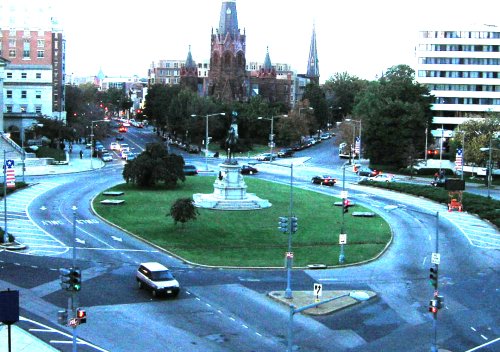
Thomas Circle before 2006. Photo from coryindc.

Thomas Circle now. Photo from Live Maps.

Thomas Circle as it could be. Photo manipulation by Chris Loos for DC Metrocentric, with some modifications by BeyondDC.
Average Rating: 4.8 out of 5 based on 196 user reviews.
April 29th, 2009 | Permalink
Tags: featured post, urbandesign

Over the next couple of weeks I’ll be moving from my current apartment in a Ballston highrise (where I’ve lived since 2004) to an English basement in Dupont Circle. Ballston has been a very livable, comfortable neighborhood, but it will be fun to be a little more central.
Posting may be sporadic for a while.
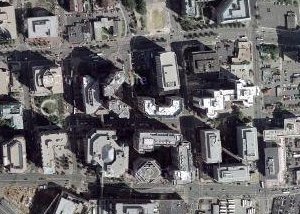
Ballston
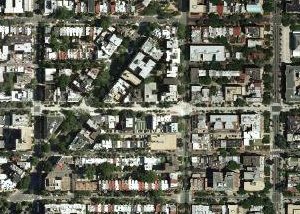
Dupont
PS: I realize that contrary to the title of this post, I’ll actually be leaving a dee-lux apartment in the sky. I apologize if your irony detectors are blaring.
Average Rating: 4.8 out of 5 based on 251 user reviews.
April 28th, 2009 | Permalink
Tags: site

Mary Peters, Bush administration Secretary of Transportation, in an August, 2007 TV interview:
“You know, I think Americans would be shocked to learn that only about 60 percent of the gas tax money that they pay today actually goes into highway and bridge construction… bike paths, trails, repairing lighthouses. Those are some of the kind of things that that money is being spent on, as opposed to our infrastructure… there’s about probably some 10 percent to 20 percent of the current spending that is going to projects that really are not transportation, directly transportation-related. Some of that money is being spent on things, as I said earlier, like bike paths or trails.”
Ray LaHood, Obama administration Secretary of Transportation, yesterday on the the USDOT blog:
“On Earth Day, it seems appropriate to talk about bicycling, not only as recreation, but as an environmentally sound commuting option… When I told the League of American Bicyclists National Bike Summit that “Cyclists are important users of America’s transportation systems, ” I meant it. And, when I wrote that “With DOT, bicyclists have a full partner in working toward livable communities, ” I meant that as well. President Obama has challenged us to transform the way transportation serves the American people by creating more choices and encouraging less carbon-intensive transportation, and we are working hard on that challenge… Earth Day is today, but we’ll need the sustained engagement of bicycle commuters and their advocates in the weeks and months to come to help keep the wheels of bicycle-friendly legislation on the road.”
There is still a lot of institutional bias towards cars and against alternatives like transit and cycling, but it’s only a matter of time until those biases are torn down (the upcoming federal surface transportation legislation could be a major turning point), and there is no better ally than a DOT boss who understands that the words “transportation” and “infrastructure” are not mere synonyms for “highways”.
For the record, lest I be accused of partisanship, Peters was a career DOT bureaucrat while LaHood is a former Republican Congressman.
Average Rating: 4.8 out of 5 based on 232 user reviews.
April 23rd, 2009 | Permalink
Tags: government, people, The New America, transportation

Commuter Connections launched an online Google Maps-based bike route finder. It works just like the well-known “driving directions” feature, but instead of selecting the fasted driving route, selects the best route for cycling.
The route finder is still in beta (and is pretty slow), but is publicly available to anyone who wants to give it a try.
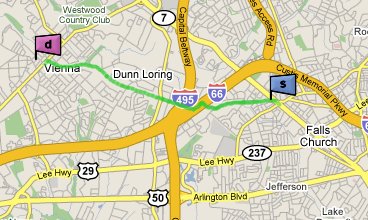
Falls Church to Vienna – the route finder knows to send you on the W&OD trail rather than streets.
Average Rating: 4.6 out of 5 based on 185 user reviews.
April 22nd, 2009 | Permalink
Tags: transportation

Cell phone photo of a new MARC locomotive in Denver, CO, sent to me by Matt Faruolo of DenverSkyscrapers.com:
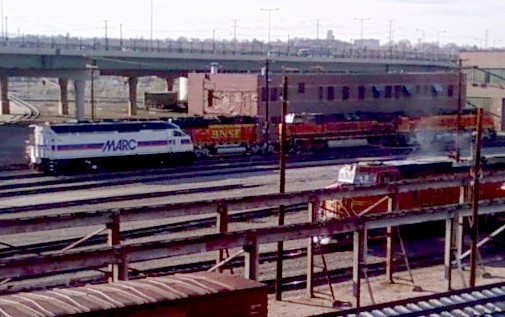
The locomotive is one of 26 MPXpress units that MARC ordered to replace aging 1970s-era GP40WH-2s. They are manufactured in Boise, ID and tested in Pueblo, CO (thus the Denver connection). The first few locomotives in the order should begin operating on MARC trains any day now, if they haven’t done so already.
Average Rating: 4.6 out of 5 based on 164 user reviews.
April 20th, 2009 | Permalink
Tags: transportation

Anyone following the BeyondDC twitter feed over the weekend may have noticed the tweet saying “MD would be a cooler state if it had a mid-size city somewhere. like if frederick or annapolis were about 5 times bigger.” What I meant by “mid-size city” was something less than a metropolis like Washington or Baltimore, but more than a satellite city like Hagerstown; something big enough to have a few skyscrapers downtown, but not to have a major league sports franchise, for example. The thought came into my head while visiting Winston-Salem, NC, which is exactly the sort of mid-size second city that Maryland lacks.
When I got home I decided to look up some population numbers to compare just how big some of the cities in the region actually are. Municipal city boundaries are too arbitrary for my purposes though; despite where the political boundaries are drawn, Baltimore is NOT a bigger place than Washington. Instead, to get real apples-to-apples comparisons, I decided to look at urbanized areas, metropolitan areas and combined statistical areas. I broadened my search to include not just Maryland, but all the population centers of the area that in my mind encompass DC’s primary sphere of influence – Maryland, Virginia except the extreme southwest portion, Delaware, West Virginia’s Martinsburg panhandle, and south-central Pennsylvania.
This is what I found:
Urbanized Areas
(w/ a population above 100, 000 as of 2000)
- Washington, DC – 3, 933, 920
- Baltimore, MD – 2, 076, 354
- Norfolk/VA Beach, VA – 1, 394, 439
- Richmond, VA – 818, 836
- Harrisburg, PA – 362, 782 (quite a gap)
- Lancaster, PA – 323, 554
- Roanoke, VA – 197, 442
- York, PA – 192, 903
- Aberdeen, MD – 174, 598
- Hagerstown, MD – 120, 326
- Frederick, MD – 119, 144
Metropolitan Areas
(w/ a population above 200, 000 as of 2007)
- Washington, DC – 5, 306, 565
- Baltimore, MD – 2, 668, 056
- Norfolk/VA Beach, VA – 1, 658, 754
- Richmond, VA – 1, 212, 977
- Harrisburg, PA – 528, 892 (quite a gap, again)
- Wilmington/Newark, DE – 500, 265*
- Lancaster, PA – 498, 465
- York, PA – 421, 049
- Roanoke, VA – 296, 532
- Hagerstown/Martinsburg, MD/WV – 261, 198
- Lynchburg, VA – 243, 580
Combined Statistical Areas
(all pertinent groupings as of 2007)
- Washington/Baltimore – 8, 241, 912
- Norfolk/VA Beach – 1, 658, 754^
- Richmond – 1, 212, 977^
- Harrisburg/York/Lancaster – 1, 021, 730^
* Wilmington/Newark are actually part of the Philadelphia metropolitan area; for the purposes of this list I broke them out using the population of New Castle County.
^ Washington/Baltimore is the only official CSA on the list. Norfolk and Richmond CSAs are the same as their MSAs. Harrisburg/York/Lancaster does not meet the federal criteria to be combined, but for the purposes of this list I wanted to know what the combined number would look like.
Comparatively, the city that triggered this line of thought, Winston-Salem, has an urbanized area of 299, 290, a metropolitan area of 463, 159, and a combined statistical area (with Greensboro and High Point) of 1, 535, 926 – fairly comparable to Harrisburg.
Is Maryland really “less cool” because it doesn’t have a Harrisburg? Not really. Nor is anybody’s life less full because the Chesapeake region doesn’t have a city filling that Richmond-Harrisburg gap (Albuquerque, Omaha and Albany would all about split the difference, in case anybody wonders). These are just the sort of thoughts that go through my geek brain.
Average Rating: 4.7 out of 5 based on 192 user reviews.
April 20th, 2009 | Permalink
Tags: in general

Despite the fact that Washington, DC grew larger by population and became wealthier between the summers of 2005 and 2008, a Transportation Planning Board report shows that the number of cars registered in the city declined by almost 6%.
Anybody out there still think adding highway capacity solves congestion? When driving is the only option, people drive a whole lot. When transit, cycling and car-sharing are easy, there are fewer cars on the road! Not only do the people who transit, cycle or car-share benefit by virtue of bypassing road congestion altogether for most of theirs trips, those people who continue to drive benefit because… say it with me now… there are fewer cars on the road!
Things can and are changing, America. Don’t let nutjobs like O’Toole convince you otherwise.
Average Rating: 4.7 out of 5 based on 248 user reviews.
April 16th, 2009 | Permalink
Tags: The New America, transportation

|

High speed rail in Taiwan |
Citing the famous Daniel Burnham quote to “make no small plans”, President Obama today pushed for high speed rail investments around the country. The highlights:
- The United States is far behind other countries in the developed world in regards to passenger rail.
- Better trains improve national security and the environment by fostering energy independence.
- A new rail network will create jobs in both the short and long term, and improve the economic situation of cities served.
- In addition to the $8 billion included for high-speed rail in the stimulus, there is a further $5 billion proposed for the regular national budget.
If America is to remain competitive in a globalized world of expensive oil, we need this kind of long term investment in modern infrastructure. The President’s dedication to rail (to the tune of $13 billion so far) is really, really fabulous news.
Average Rating: 4.6 out of 5 based on 217 user reviews.
April 16th, 2009 | Permalink
Tags: government, The New America, transportation

Turns out there’s a musical about the Purple Line called Tracks.
I’m a big fan of the Purple Line, but it never occurred to me to sing about it.
Update 4/16: Much more info about this in an interview by Just Up The Pike.
Average Rating: 4.6 out of 5 based on 172 user reviews.
April 15th, 2009 | Permalink
Tags: fun, transportation

Read:
Among those who say U.S. consumption of gasoline has peaked are executives at the world’s biggest publicly traded oil company, Exxon Mobil Corp
|
|
Since Henry Ford began mass production of the Model T nearly a century ago, car-loving Americans have gulped ever-increasing volumes of gasoline. A growing number of industry players believe that era is over.
Among those who say U.S. consumption of gasoline has peaked are executives at the world’s biggest publicly traded oil company, Exxon Mobil Corp., as well as many private analysts and government energy forecasters.
The reasons include changes in the way Americans live and the transportation they choose, along with a growing emphasis on alternative fuels. The result could be profound transformations not only for the companies that refine gasoline from crude oil but also for state and federal budgets and for consumers. Much of contemporary America, from the design of its cities to its tax code and its foreign policy, is predicated on a growing thirst for gasoline.
…
Demand for all petroleum-based transportation fuels — gasoline, diesel and jet fuel — fell 7.1% last year, according to the EIA. This is the steepest one-year decline since at least 1950, as far back as the federal government has reliable data.
Many industry observers have become convinced the drop in consumption won’t reverse even when economic growth resumes. In December, the EIA said gasoline consumption by U.S. drivers had peaked, in part because of growing consumer interest in fuel efficiency.
Exxon believes U.S. fuel demand to keep cars, SUVs and pickups moving will shrink 22% between now and 2030. “We are probably at or very near a peak in terms of light-duty gasoline demand, ” says Scott Nauman, Exxon’s head of energy forecasting.
…
Americans are changing, too. Demographic shifts that once spurred higher gasoline consumption have run their course, such as more women joining the work force and the flight to the suburbs.
More people are minimizing their commutes by living closer to their jobs. Inner cities and surrounding suburbs are growing denser, shortening trips to work and to the mall. Between the early 1990s and 2007, the majority of metropolitan areas in the U.S. saw an increase in the share of residential permits granted near or in their downtown centers, according to the Environmental Protection Agency.
…
A growing number of Americans are commuting by bus or train or working from home. And even as the population continues to rise, the rate of gasoline consumption appears to be slowing. From 1960 to 1970, the U.S. population grew 13% while vehicle miles rose 54% and gasoline demand 45%, according to government data. Between 1990 and 2000, the population grew at the same 13% rate, but miles driven rose only 28% and gasoline demand by 17%.
All that according to the Wall Street Journal, hardly a liberal or green-leaning source.
If even the likes of the WSJ and executives from Exxon-freaking-Mobil are saying these things, isn’t it time the Wendell Coxes and Randall O’Tooles of the world stopped pedaling their nonsense wares?
Average Rating: 4.4 out of 5 based on 150 user reviews.
April 14th, 2009 | Permalink
Tags: environment, The New America, transportation

|
Media





Site
About BeyondDC
Archive 2003-06
Contact
Category Tags:
Partners
|





















